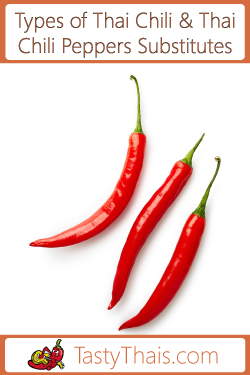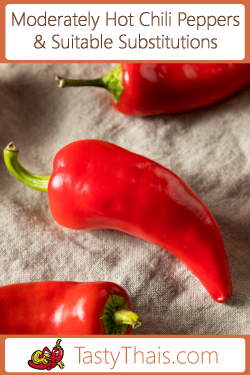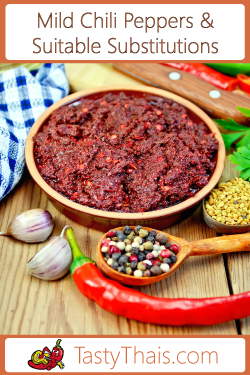For the brave or the stupid or those who have built up a tolerance for spicy food, these hot chili peppers are about as hot as you want to get.
There are other hotter chilis such as the Dragon’s Breath chili that are cultivated to win the prize of the hottest chili in the world but good for little else. We haven’t bothered listing those because they are culinary dinosaurs more than dragons!
You might like to take a look at our other articles on chilies:
Cooking with Chilies & Using Substitutes
Thai Chili types and International Substitutes (with infographic)
Mild Chilies & Substitutes
Moderately Hot Chilies & Substitutes
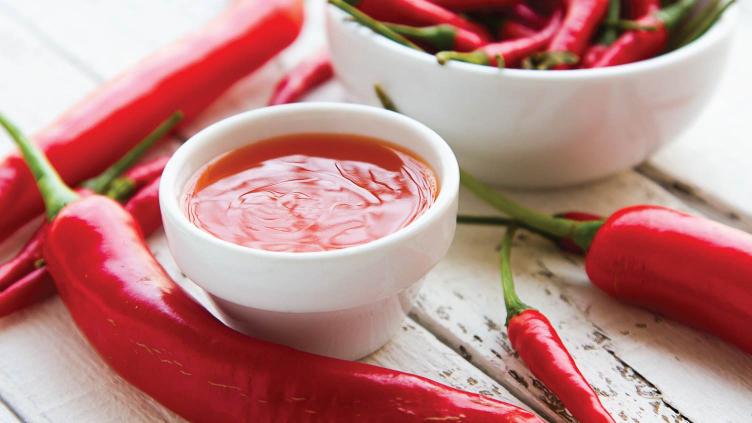
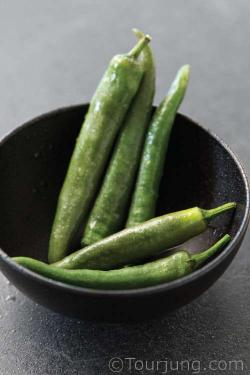
Serrano Pepper
Serrano peppers are another popular chili pepper which is similar in taste to the Jalapeno but mostly significantly hotter – around three times hotter!
Another pepper which is usually harvested while still green, they are used in the Southwest USA extensively though less than the popular Jalapeno.
If you are cooking spicy food regularly and finding that your dishes could do with a little more heat for your preference then the Serrano pepper can provide that without increasing the number of chilies used in a recipe.
What is the Best Substitute for Serrano Chili?: Jalapeno. Cayenne, Thai Luang (yellow)
SHU: Around 15,000
Spice Level: – Moderate to Quite Hot
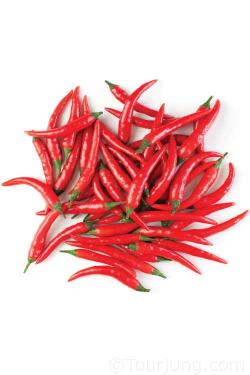
Cayenne Pepper
The Cayenne pepper is an iconic chili shape, fingered with a curved pointy end. They are very like the Thai Jinda peppers in color and shape.
They range in spiciness from a little mild to hot, so it depends on the growing conditions and type as to how spicy any particular pepper is.
At their spiciness, they are about as hot as the Thai Jinda peppers but otherwise quite a lot milder.
Although you can find these peppers fresh, they are more often dried and dried to make Cayenne Pepper which you find at most food stores.
A little tip if you are starting out cooking spicy food or making an unfamiliar recipe – use less chili pepper than the recipe calls for. If the dish is still too mild when you have finished you can make a note to use more fresh next time and top up the dish you are cooking with a little added Cayenne.
What is the Best Substitute for Cayenne:
For Cayenne Powder: Regular Chili powder, Chili flakes further pulverized, Tabasco
For Fresh: Thai Jinda Chili, Serrano, Tien Tsin, Fresno (will be milder)
SHU: Ranged around 40,000
Spice Level: Quite Hot to Hot
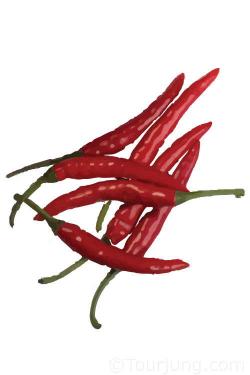
Jwala Finger Chili
This chili is another that resembles the Thai Jinda Chili as well as the Cayenne chili but originating in India where it is widely cultivated.
It is used mainly in Indian recipes and is a pretty hot chili.
It is quite likely that the Thai Jinda chili is a derivative of the Jwala as it shares many characteristics even though it is quite a bit milder.
It’s a similarity to the Cayenne chili may be because the Asian chilies were cultivated from plants imported to Asia by traders several hundred years ago.
What is the Best Substitute for Jwala?: Thai Jinda Chili (hotter), Serrano, Cayenne, Tabasco, Chile de árbol, Tien Tsin.
SHU: Around 25,000
Spice Level: – Medium Hot
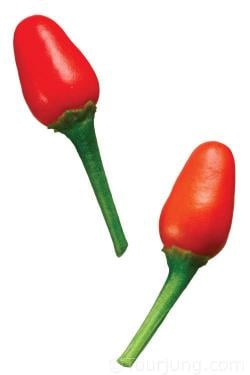
Pequin (Piquin) Chili Pepper
The Pequin or Piquin pepper is an almost rectangular shape and quite short and squat around an inch long.
These are hot chili peppers that are quite hard to find because cultivation is limited.
They are round and smoked over wood to provide their signature taste.
If an esoteric recipe calls for these then you will most likely want to substitute for Chile de árbol which is easier to find.
What is the Best Substitute for Pequin (Piquin) Chili?: Chile de árbol (not so smokey), Tien Tsin (not so smokey), Tabasco, Thai Jinda (for heat), Cayenne (heat and taste)
SHU: Around 45,000
Spice Level: Hot
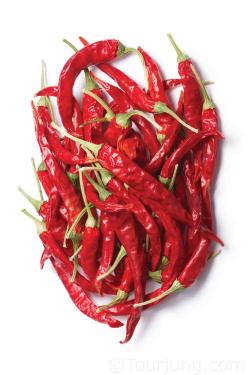
Chile de árbol
The Chile de árbol is another finger type typical chili pepper shape.
It looks a little like Thai Jinda chili though a little more knarled as the bird’s eye type chilies tend to be.
These hot chili peppers are cultivated in Mexico and used in the hotter dishes.
What is the Best Substitutes for Chile de árbol?: Tabasco chili, Thai Jinda, Jwala, Cayenne, Serrano, Tien Tsin
SHU: Around 50,000
Spice Level: Hot
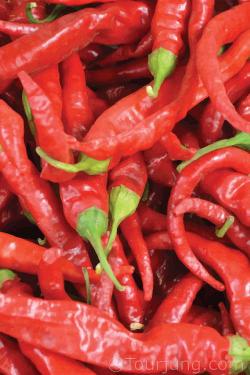
Tien Tsin Chili
The Tien Tsin chili comes from Northern China and is a hot chili used sparingly in some Chinese dishes – usually Szechuan or the popular Kung Pao Chicken dishes.
It is not commonly found in the West but is commonly called the Chinese Red pepper and is usually dried.
They are a small bird’s eye type shape but significantly milder (though still hot) than the Thai Jinda and bird’s eye chilies.
What is the Best Substitutes for Tien Tsin?: Regular Chili Powder, Cayenne, Tabasco, Dried Ground Thai Jinda.
SHU: About 60,000
Spice Level: Hot
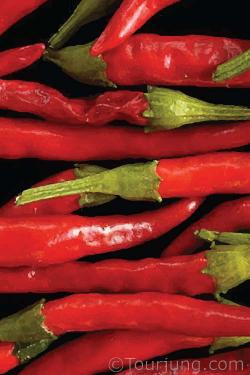
Yatsafusa Chili
The Yatsafusa is the Japanese counterpart to the Thai Jinda chili.
Similar in shape though slightly milder, it is grown in Japan and used sparingly to season Japanese food.
You will often find it as a condiment in vinegar or oil on tabletops in the same fashion as Thai street food and mainstream restaurants.
What is the Best Substitutes for Yatsafusa?: Thai Jinda, Fresno Chili, Hot Anaheim, Jalapeno, Cayenne, Serrano, Jwala – adjust for spiciness
SHU: Around 65,000
Spice Level: Hot
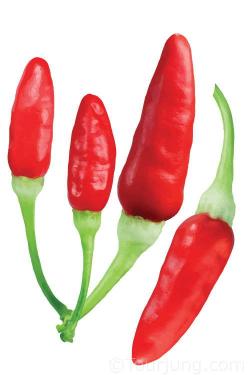
Tabasco Chili Pepper
Tabasco sauce is probably responsible for the reputation of the Tabasco pepper.
These short chilies are like fattened smooth birds’ eye chilies that are a kind of yellow-green and turn to red when they ripen.
Although they can be found fresh, they are most commonly encountered in Tabasco sauce which is a great way to spice up a dish if the chilies you bought were a little milder than expected or if you did not use enough.
The sauce is a great way to add chili because it avoids clumping that can occur if you are not carefully adding powdered chili – it distributes better through the dish.
What is the Best Substitutes for Tabasco?: Thai Jinda, Jwala, Cayenne, Serrano, Tien Tsin, Yatsafusa, Chiltepin (hotter)
SHU: Around 60,000
Spice Level: Hot
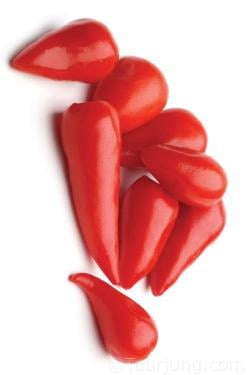
Malagueta Chili Pepper / Piri Piri (Peri Peri)
The Malagueta Chili is like a scaled-down version of the average thin, hot finger chili. At about 2 inches long it is widely used in the Portuguese speaking parts of South America such as Brazil, in the Caribbean and of course Portugal.
The chilies that are picked early are called Malaguetinha or more commonly Piri-Piri or Peri. They are smaller and hotter than the ones that are picked when riper and fully grown.
The spice heat range for the fully grown Malagueta chili is hot but varies significantly from Moderately Hot to Hot – about as hot as Thai Jinda Chili.
The young Malagueta chilies or Peri-Peri / Piri Piri chilies are much hotter – Very Hot on our scale..
What is the Best Substitute for fully grown Malagueta Chili: Thai Jinda, Tabasco, Chiltepin, Thai Bird’s Eye Chili, Cayenne, Prik Kee Nu, Cayenne
What is the Best Substitute for Peri-Peri Chili: Thai Prik Kee Nu, Haberano, possibly Scotch Bonnet.
SHU: Malagueta – Around 60,000
Peri-Peri / Piri Piri – Around 175,000
Spice Level: Hot
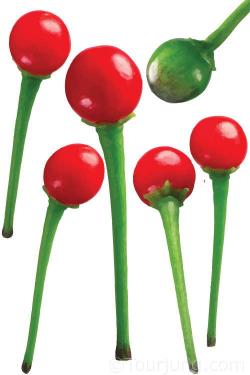
Chiltepin Pepper
The Chiltepin pepper is a small round pepper that is very hot.
It comes from the same plant as the Pequin chili but is sun-dried rather than smoked.
The green chilies are particularly hot and the red chilies, which have ripened more, are a slightly lesser version of hot.
This tiny ball of heat is potent so beware how many you add to your cooking.
Substitutes for the Chiltepin: Thai Jinda, Thai Prik Kee Noo, Thai Prik kee Nok, Peri Peri, Malagueta
SHU: Around 75,000
Spice Level: Hot to Very Hot for the less ripe green chilies
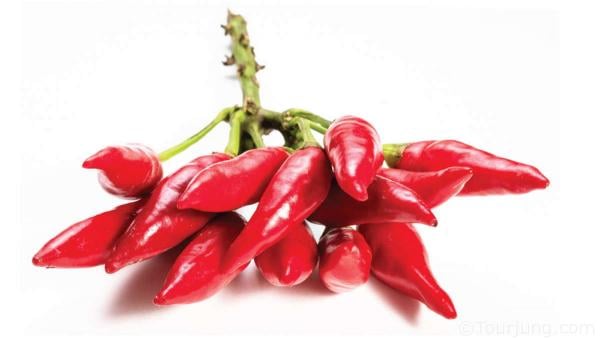
Siling Labuo Chili
The siling labuyo chili is a hot little chili that grows upwards pointing at the sky and is common in the Philippines.
It looks much like the bird’s eye chili but in fact, is from a different cultivar. The siling labuyo is from the Capsicum Frutescens species rather than the Capsicum Annum species that the majority of chili plants belong to.
Regardless of this the heat level and appearance are similar to bird’s eye chilies and they both have a very hot spice level and are used when you want a very intense heat in your dish.
What is the Best Substitute for Siling Labuyo?: Thai Bird’s Eye Chili, Thai Prik Kee Nu, Siling Labuyo
SHU: Around 85,000
Spice Level: Very Hot
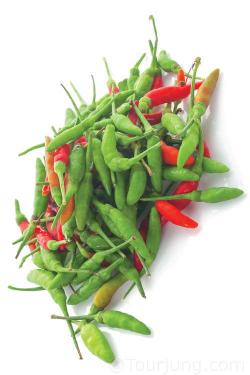
Thai Bird’s Eye Chili Peppers – Prik Kee Nok & Prik Kee Nu
The Thai Bird’s Eye chili pepper comes in one of two variations that look fairly similar and are both very hot.
They are similar to the Philippine Siling Labuo peppers and used to create intense heat in a dish – mostly used in hot Thai soups but not exclusively.
The Thai Prik Kee Nok is slightly less hot (usually) than the Thai Prik Kee Nu which is usually a little smaller and hotter.
The other difference is the shape of the tip where the Prik Kee Nok has a more tapered and pointed tip and the Prik Kee Noo a squarer and more rounded conical appearance.
What are the Best Substitutes for Thai Prik Kee Nok & Prik Kee Nu?: Siling Labuyo, Cayenne, habanero
SHU: Around 100,000
Spice Level: Very Hot
Peri-Peri
See Malagueta
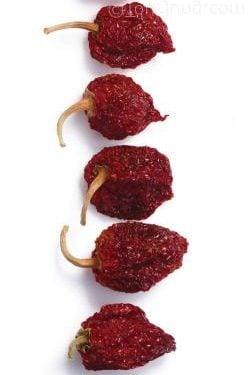
Habanero Chili Pepper / Scotch Bonnet
The habanero Chili pepper probably originated in Peru where domestic specimens well over 8,000 years old have been found in archaeological digs.
These chili peppers are very very hot bordering on extreme and are grown in several areas especially Mexico but including the Southern USA, Mexico, Costa Rica, Panama, Columbia, and Ecuador.
Once famed as the hottest chili but since overtaken by several other cultivars crossbred to achieve the hottest chili hall of fame.
The orange Haberano chili is one of the hottest chilies used in regular dishes in various regions where very spicy food is eaten such as Mexico, other South American and some of the Caribbean islands as well as dishes that have been adopted in Southern USA cooking.
What are the Best Substitutes for Haberano?: Bird’s Eye Chili, Cayenne, Siling Labuyo, Thai Prik Kee Nu, Thai Prik Kee Nok, Malagueta
SHU: Wide range from 100,000 up
Spice Level: Extreme
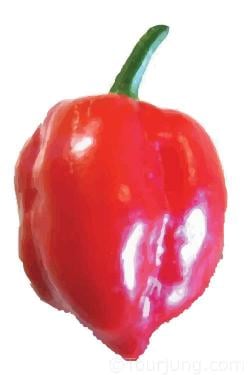
Red Savina Chili
The Red Savina is basically a dark red habanero variant that is slightly hotter and of course a red rather than the orange color of most harvested habaneros.
Although available they are much less common than the orange habanero.
These chilis are really only for special use and should be handled with care.
What is the Best Substitute for Red Savina?: habanero, Bhut Jolokia, Carolina Reaper or a sensible recipe!
SHU: Around 300,000 up
Spice Level: Extreme
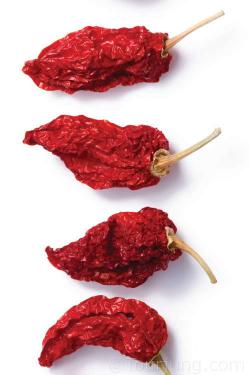
Bhut Jolokia Chili
The Bhut Jolokia is perhaps the hottest chili in common culinary use. That said the culinary use is mainly confined to dishes originating and consumed in Northeast India where the chili is found.
It is an exceptionally hot chili used to heat up curries, sauces, and pastes.
Unlike most other hot chilies the Bhut Jolokia is larger than most coming in at around 3 inches long and has a thinner fleshy part.
Be very careful with these peppers since the capsaicin is unusually distributed quite evenly in the fruit rather than the usual concentration in seeds and the pithy placenta.
There are two versions, one with rough skin and one with smooth but they are equally potent.
What is the Best Substitute for Bhut Jolokia?: habanero, Red Savina or Carolina Reaper or work on common sense?
SHU: Around 800,000 up
Spice Level: Extreme
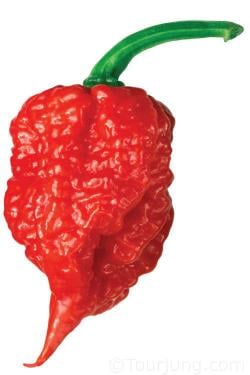
Carolina Reaper / Ghost Pepper/ Dragon’s Breath
These chili peppers are all crossbred chilis with the habanero chili and specifically engineered to be of extreme heat.
They are rarely used for cooking and certainly not in widespread use.
In culinary terms they are oddities but the seeds are readily available so it seems that some people are into growing them.
Be careful handling them as the chili oil they contain is dangerous to your eyes and soft tissues.
What is the Best Substitute for Carolina Reaper and Ghost Chili?: A new brain!
SHU: 1-2 million
Spice Level: Absurd
Don’t forget to refer to the table above to select the best types of chili pepper to use as a locally available substitute for the recipe you are following.
